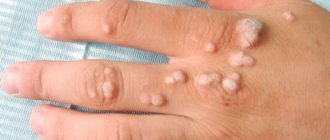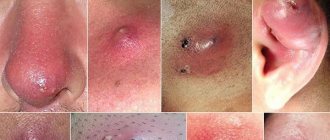Publication date: July 03, 2014.
Now many people decide to undergo a procedure such as mole removal. After all, they are not always pretty, and sometimes cause discomfort. But what are the consequences of removing moles? Will there be a huge scar left, will the mole grow again? First, let's figure out what neoplasms can appear on human skin?
Normal healing process
It is considered normal for the mole removal site to hurt for several weeks. If the nevus is large, it will likely take longer to heal. Everything will depend on the specifics of each human body.
Signs of healing
- Minor pain;
- Slight redness of the skin;
- Crust formation.
© shutterstock
If after surgery a person is bothered by any extraneous signs, it is better to go to the hospital in a timely manner to avoid serious complications.
Treatment options
After a few days, a crust appears on the wound, which cannot be wetted or torn off independently in order to avoid infections.
Conservative methods of treating pain after mole removal include:
- Potassium permanganate;
- Healing ointments;
- Sunscreens.
Should you see a doctor with these symptoms?
If deviations appear after removing a mole, atypical symptoms, pain, even if the symptoms stop spontaneously, it is recommended to consult a doctor to avoid complications.
There is no need to self-medicate or use traditional medicine methods. You can aggravate the pathological condition and provoke complications after removal. It is forbidden to scratch the postoperative wound.
It is necessary to pay attention to acute symptoms. If certain signs appear, you should immediately contact the dermatology department:
- atypical discharge from the wound - blood, pus, serous clear liquid - one-time or constant;
- raising body temperature to 39-40 degrees. Prolonged hyperemia, which is poorly treated with antipyretics and NSAIDs;
- acute and throbbing pain, difficult to relieve with medications. Taking ibuprofen or aspirin should be avoided: they increase the risk of bleeding from a postoperative wound.
The doctor will determine the nature of the changes, conduct diagnostics, and help differentiate pathological symptoms from normal processes of epithelization of the postoperative wound. If necessary, he will prescribe additional biochemical tests or histological examination of tissue from the surgical area.
Infiltrate
Removing a mole is a common manipulation in medical practice, which takes place without complicated consequences. But sometimes a red bump appears at the site of mole removal - an infiltrate that can cause pain.
© shutterstock
This phenomenon is explained by the fact that cellular elements with blood and lymph have accumulated in the tissues. The cause of the disease is:
- Damage to soft tissues;
- Poor blood clotting;
- Improper postoperative care;
- Penetration of infection.
Signs of infiltration
The disease does not manifest itself with many symptoms, but among them are:
- Pain from touching the place where the mole was removed;
- Local redness of the skin.
If the disease does not provoke inflammatory processes, signs may be completely absent.
Under any circumstances, it is worth visiting your doctor again in order to avoid unpleasant outcomes.
Treatment options
To eliminate infiltration, doctors use:
- Regeneration therapy;
- Antibacterial drugs;
- Physiotherapeutic procedures.
All medications must be strictly prescribed by a doctor.
Which moles are dangerous and require removal?
In most cases, small moles and medium-sized formations are not dangerous and require only dynamic monitoring by a specialist. But sometimes surgical removal of the tumor is necessary.
Mole removal is carried out in the following cases:
- when the shape and size of a mole changes;
- if the tumor is constantly injured (by clothing, linen, comb);
- a mole brings severe psychological discomfort due to its size or repulsive appearance, etc.
Several methods are used to remove tumors - conventional surgical excision, radiofrequency method, cryodestruction, but the safest and most effective method is laser removal of moles.
Thermal burn
When a person decides to remove a mole, he should carefully study each technique and make the right decision. For example, if, after removing a mole, the place where burning with liquid nitrogen was carried out hurts, then this is a thermal burn. It is formed due to the substance entering healthy tissue.
© shutterstock
This method has some caveats and is contraindicated for people who:
- Infectious diseases;
- Herpes;
- Arterial pressure;
- Mental disorders;
- Lactation;
- Pregnancy.
Signs of a burn
- Burning;
- Local redness;
- Edema.
Treatment options
You can get rid of a burn with the help of wound-healing ointments, which should be prescribed by your doctor.
Selecting a removal method
So, an oncologist or dermato-oncologist recommended removing the mole, or you decided to get rid of the formation. Consult with a specialist which removal method is best for your situation.
In many cases, histological examination of a removed mole is a mandatory procedure. It is important to evaluate the structure of the nevus tissue and make sure that the formation is truly benign and that nothing threatens your health. In this case, traditional mole removal with a scalpel is one of the most suitable methods. Some modern instruments do not leave a trace of tissue, so it will not be possible to study them in the laboratory.
If a large mole is located on the face or open areas of the body, discuss with a specialist the prospects of using a laser or radio wave removal method. These methods have fewer cosmetic consequences - they do not leave noticeable scars, so it is often advisable to resort to them. Remember that health is more important - if the doctor insists on conventional surgical removal, you should listen, because the prevention and early diagnosis of cancer depends on this.
Hypertrophic scar
As a rule, after professional removal of a mole, a barely noticeable scar or no trace remains on the body. Of course, it all depends on the chosen method, including :
- Laser;
- Radio waves;
- Electrocoagulation;
- Cryodestruction;
- Surgery.
© shutterstock
But, if healing is accompanied by some disturbances, then a hypertrophic scar appears at the site of the removed mole - stretched skin, causing pain and discomfort.
This disease occurs due to excess collagen produced by multiplied cells. Fibroblasts are cells that are supposed to eliminate excess collagen formation. As a result of these disorders, a hypertrophic scar is generated.
Signs of illness
Signs of the disease include:
- Pain in the affected area;
- Discomfort of movements;
- Visible skin changes.
Treatment options
When a scar from a mole hurts, doctors prescribe:
- Drug therapy;
- Physiotherapy;
- Radiation therapy;
- Laser grinding.
How to treat a scar
Treatment before the process of removing moles using one of the surgical methods and care after surgery are mandatory components of preventing the development of negative reactions. If there is pain in the scar area, you can use medications:
- antiseptics to relieve discomfort, eliminate secondary microflora - brilliant green, alcohol, iodine solution, Betadine, Miramistin, Chlorhexidine bigluconate;
- dyes with a drying effect to stimulate epithelization, eliminate a weeping wound, and rapid healing - Fukortsin, Castellani paint;
- ointments that relieve inflammation - Levomekol, Solcoseryl, Streptomycin, Baneocin, Betamentasone, ointments with Panthenol;
- ointments and creams that stimulate suture contraction and skin regeneration after surgery - Kontraktubes, Mederma;
- natural oils, herbal decoctions for rubbing and relieving pain - milk thistle oil, sea buckthorn, St. John's wort, aloe;
- Actovegin – stimulates regeneration at the cellular level.
Suppuration
After removal of the nevus, pain is caused by suppuration, which can be seen by everyone. In case of such manifestations, it is recommended to immediately visit a doctor.
© shutterstock
The consequence of suppuration is:
- Negligent attitude to the doctor’s rehabilitation instructions;
- Staphylococcus;
- Pseudomonas aeruginosa;
- Various microbes;
- Chronic inflammatory process;
- Lack of personal hygiene;
- Dirty water.
Signs of illness
Signs of suppuration include:
- Poor wound healing;
- Local redness;
- Paroxysmal pain;
- Heat;
- Purulent discharge;
- Swelling.
These signs are evidence of a serious complication that requires urgent and appropriate treatment.
Treatment options
To treat suppuration that has formed at the site of a removed mole, antibacterial therapy is used, including:
- Antimicrobial ointments and powders;
- Zelenka;
- Potassium permanganate;
- Sometimes, antibiotics.
Preparing for the intervention
No preparation is required for surgery: you can eat and drink water without restrictions, and you do not need to take medications. However, it is important for women to plan the day of surgery taking into account the menstrual cycle; it is better to do this after menstruation. The recommendation applies to any surgical intervention. Also, in cases where the nevus is located on open areas of the body, it is better to remove it from October to April. This will eliminate the need to hide the wound and protect it from ultraviolet rays.
If you are taking medications that affect blood clotting, tell your surgeon. You should not stop taking medications on your own—check with your doctor.
Melanoma
Many people are interested in whether it hurts to remove a mole, but few are interested in the consequences, because beauty and comfort always come first. Sometimes, the mole itself becomes the cause of illnesses. But, before you go for an operation to remove it, you should find out the nature of its occurrence and possible consequences.
© shutterstock
Pain after mole removal is caused by melanoma, an oncological disease that is a type of skin cancer. According to statistics, 200 thousand people in the world die from melanoma every year.
Scientists to this day have not been able to find out the exact causes of the disease, but they have been able to identify some factors that contribute to the development of melanoma, which causes pain after mole removal:
- Genetic predisposition;
- Ultraviolet irradiation;
- Hormonal imbalances;
- Sunburn;
- Age category over 50 years.
Signs of illness
Signs of melanoma formation include:
- Pain at the site of the removed mole;
- Itching;
- Burning;
- Redness of the skin;
- Edema.
Proper removal of a mole is a reliable measure for preventing the disease. Pain and tumor formation can provoke the following cases:
- Traumatic removal methods;
- Incomplete removal of a mole;
- The presence of cancer cells in the body.
Therefore, if after removal of a mole pain appears or the area begins to itch, you should immediately seek advice from specialists.
Treatment options
To get rid of melanoma that causes pain after removing a mole, doctors do a repeat procedure, including:
- Surgical intervention;
- Chemotherapy;
- Immunotherapy;
- Radiation therapy.
© shutterstock
When deletion is indicated
Epidermal nevi are benign formations and are harmless to health. However, any nevus carries a potential threat; there is a possibility of degeneration into a malignant tumor - melanoma. This is one of the most dangerous types of cancer. Therefore, it is important to monitor existing moles and consult a doctor if there is the slightest change.
You should visit a dermatologist as soon as possible in the following cases:
- the mole has increased in size, changed color, shape, outline;
- pain, itching, bleeding, burning, peeling, ulceration appeared, the surface became lumpy and uneven;
- the nevus was injured.
There is a high risk of degeneration for nevi located in open areas of the body. This is due to intense exposure to ultraviolet rays during the hot season. Also subject to removal are nevi that are constantly injured by elements of clothing - the handle of a bag, a collar, elastic bands of underwear, etc. Those formations that are located on the hairy areas of the body are also at risk - there is a possibility of tissue damage during shaving, waxing or sugaring.











